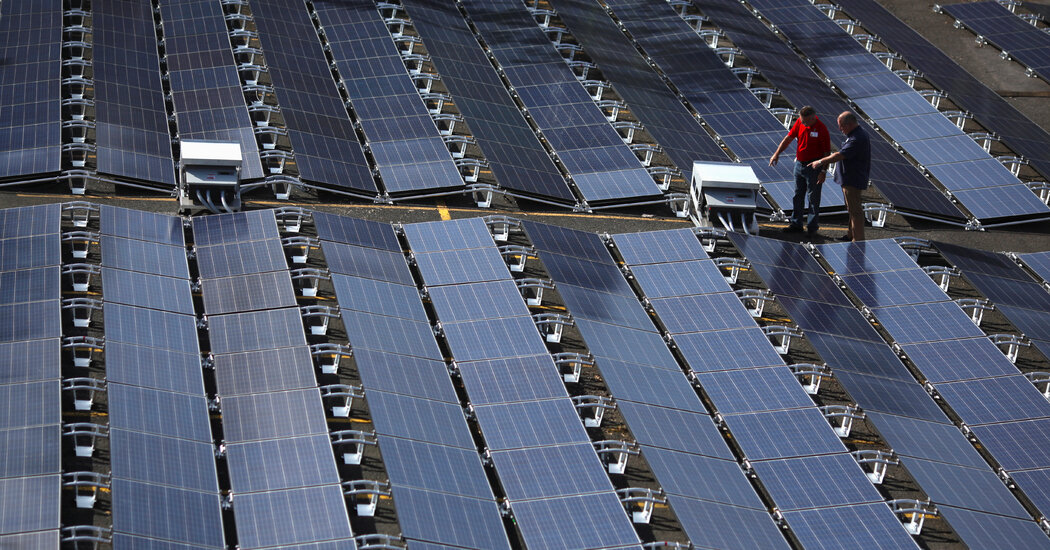- cross-posted to:
- nyt_gift_articles@sopuli.xyz
- energy@slrpnk.net
- cross-posted to:
- nyt_gift_articles@sopuli.xyz
- energy@slrpnk.net
The federal government plans to reimburse state and local governments that rebuild damaged public buildings to be more energy resilient.
The Federal Emergency Management Agency will begin paying to install solar panels on schools, hospitals and other public buildings that are rebuilt after disasters, making them more resilient against future disasters while reducing greenhouse gas emissions.
The change, set to be announced on Tuesday, reflects the disaster agency’s decision to use federal dollars to expand renewable energy as it copes with worsening climate shocks.
The number of billion-dollar weather disasters keeps rising, straining the country’s ability to respond, as well as the ability of local officials to keep offering basic services to residents.
“If you’re installing solar panels, you are creating more energy independence,” Deanne Criswell, FEMA’s administrator, said in an interview.
The change comes amid major shifts in America’s response to disasters. Insurers are withdrawing from high-risk areas. People are donating directly to survivors through the crowdfunding platform GoFundMe, although that money largely benefits the wealthy. FEMA is overhauling its programs to help individual disaster survivors, after acknowledging that the current programs often fail to provide adequate support.
Wouldn’t it make more sense to build out energy resources in areas that don’t suffer from disasters, rather than just throw money at/reward folks for living in untenable places as climate shifts?
As a counterpoint, disasters are unpredictable, so you can’t say that the buildings themselves will be destroyed again, nor can you say “well, guess y’all dont get schools and utilities since a disaster destroyed them.”
Improving energy efficiently and adding renewal resources is far easier and cheaper to do at time of construction, so its a solid move to add funding for a building that you know will be rebuilt either way.
That’s solid. It’s not that I think we shouldn’t rebuild in those communities, I’m grousing at the perceived unfairness of favoring higher risk areas for renewables, but the new building/retrofit line of thought is a good one, and makes a lot of sense.
This is coming from FEMA. Emergencies and disasters are kinda their thing.
How about before the disasters too?
Makes more sense to do it after if you’re going to do this. Usually after a disaster you have to do something with the roof, electric service equipment, and even the electric utility equipment. These are also things that need to be touched when you’re just simply adding solar. So if there’s going to be aid following a disaster, it makes logistical sense to tack on solar since the overall cost of doing it with everything else should, in theory, cost less.
Obviously the costs may not be kept lower if there’s a way for contractors to game the system.
Yay!
I had a business idea (Which I’ll never do because that is too much work) where I essentially go around and just buy/lease people’s roofs and install solar panels on them. I’d pay either a portion of the energy re-sell value over a very lengthy period of time, or a flat estimated portion amount of return. I feel like solar’s biggest issue is mostly land so people don’t really do much with their roof, it’s free real estate!
Instead of someone coming by and saying “Pay us to put solar on your roof” you’d get me going “I will pay you to let me put a thing on your roof which you will probably never notice, I’ll even insure the roof so if there is storm damage to your roof I’ll cover it”.
Add in the situation where you decide to keep the panels you can buy them off me by either buying it straight up, or letting me just keep the portion I would be giving you for some amount of time, then your roof and the panels’ ownership would revert back to the homeowner.
Couple issues with that. One is how to get it to work and be approved by the utility. In many areas something like this is heavily regulated and you might not even be able to do it depending upon State law (assuming you’re in the States).
Another issue is that in many areas, unless you’re only offsetting the home or business, the excess isn’t profitable. Many utilities pay a fraction of what they charge for any excess put back on the grid.
That being said, I know some utilities are actually doing this. They’re renting roof space on large commercial and industrial buildings. It’s more profitable for them since they can get full market rate for the energy generated.





